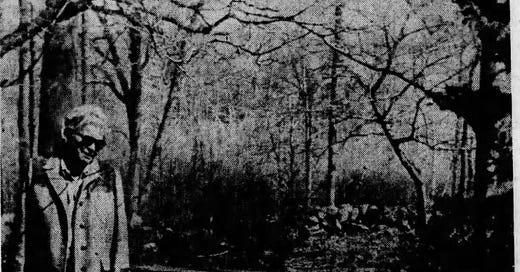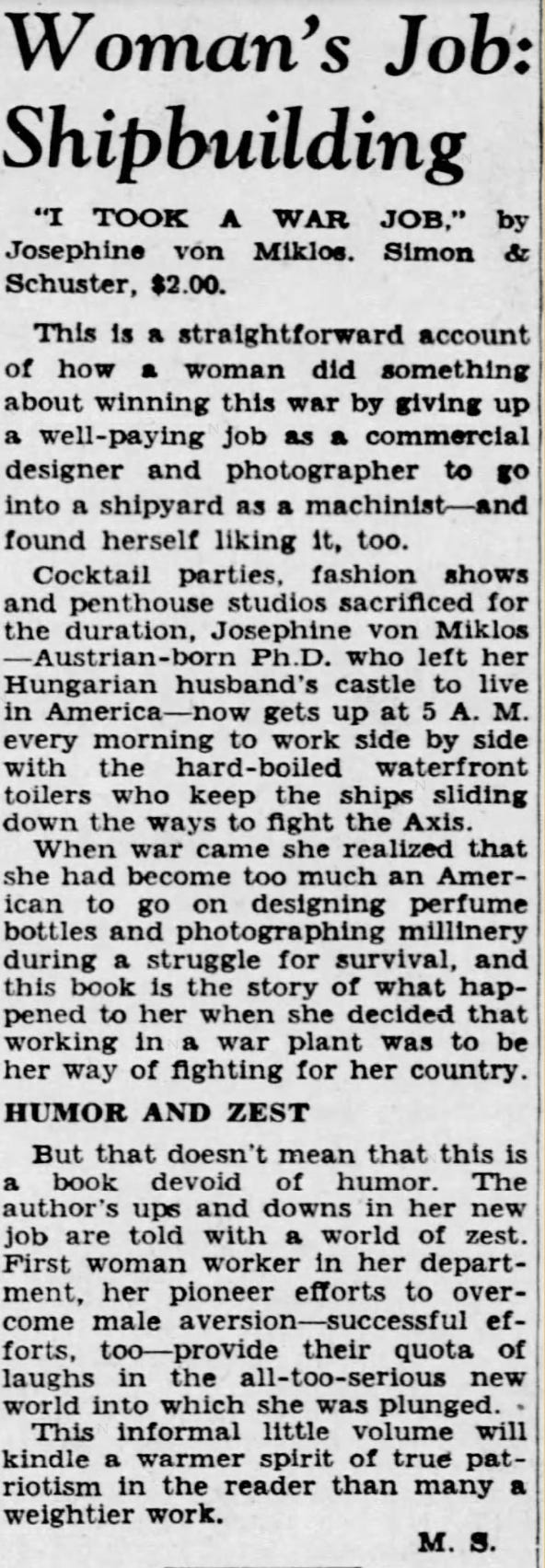Married to a baron. Had at least two patents for perfume bottles. Earned a doctorate in art history. Immigrated to the United States in the 1930s. And worked in a munitions factory during World War II.
Those were just a few of the fascinating facts I discovered about Josephine von Miklos, whose list of accomplishments also included writing four gardening-related books, making her the latest Lost Lady of Garden Writing.
Her Biography
The New York Times published an obituary for Josephine von Miklos in November 1972, a few days after she died.
Dr. Josephine Bogdan von Miklos, photographer, designer and author, died yesterday in Norwalk (Conn.) Hospital. She was 72 years old and lived in Pound Ridge, N.Y.
Dr. von Miklos, who was born in Vienna, received a Doctor of Art History degree from the University of Vienna and came to the United States in 1930.
In March, 1942, she interrupted her career as a product and package designer, because she “felt too patriotic to continue designing pretty things during the war,” and went to work on an assembly line in a munitions plant. Out of this experience came her book, “I Took a War Job.”
After the war Dr. von Miklos resumed her career as a photographer and designer. She designed packages for Henri Bendel, General Foods, Macy's, Elizabeth Arden and other large concerns.
Her avocations were gardening and woodworking — she built her own house at Pound Ridge. Her recent books included “Wild Flowers in Your House,” “The Gardener's World,” “Illustrated Guide to Personal Gardening” and “Good Fences Make Good Neighbors.”
Dr. von Miklos taught photography at her studio as a labor of love. She was a trustee of the Hiram Halle Memorial Library in Pound Ridge and founder of the Pound Ridge Conservation Council.
She was married to the late Baron Elemer von Miklos of Hungary. A brother, Norbert Bogdan of New York, survives. (New York Times, November 3, 1972)
Her Other Careers
Josephine’s first 30 years were spent in her native Austria, where she earned a doctorate in art history, and met and married a Hungarian baron. When she moved to the United States, she divorced her husband and worked as “product and package designer.” I found two patents with her name on them, one for a bottle, the other for a jar.
When World War II started out, she went to work in a munitions factory and later worked in a shipyard. As noted in her obituary, she wrote a book about her experience: “I Took a War Job.” The Philadelphia Inquirer published an article about the book in July 1943 which gives a little more insight into the life Josephine lived before the war.
The movie producer David O. Selznick took notice of her book and asked her to come to Hollywood to help write the script for a movie he was producing called “Since You Went Away” about a woman left to raise her two teenage daughters when her husband went off to war. She went there for two weeks to help, taking a break from her other war work, though she isn’t listed in the movie credits.
Before and after her war work, as mentioned in her obituary, Josephine worked as a photographer and designer, and along the way, built much of her own house and became involved in gardening.
Her Gardening Books
Josephine wrote four books related to gardening:
Wild Flowers in Your House (!968)
The History, the Beauty, the Riches of The Gardener's World, with Evelyn Fiore (1968)
The Illustrated Guide to Personal Gardening (1972)
Good Fences Make Good Neighbors (1972)
I know nothing about three of the books, but do have a copy of The Illustrated Guide to Personal Gardening. From the introduction, Josephine writes that this book won’t tell you exactly what to do in your garden but will help you think about the garden.
Her Gardening Philosophy
In an article in The Plain Dealer, Cleveland, Ohio, in 1970, Josephine is quoted as saying, “I am a howling conservationist.”
She also said, “I would like to kill the status garden. We should make more use of nature. Wildflowers must be saved.” (Sentiments like that are still being written today!)
She further noted, “Some nations, like Japan, flourish in their gardens. England is another one of these. I am impressed by European townhouse gardens where residents grow wildflowers among the roses.”
And one last quote from that article… “If you love a plant and talk to it, it will grow for you. That is the only way.”
If Only…
Wouldn’t you love to still be able to visit Josephine in her home in Pound Ridge and listen to her tell stories of growing up in Austria, attending school in Vienna, and marrying a baron with his own castle? In one article I found, she mentioned getting her first camera when she was about 10 years old and how she would take it on Sunday hikes through the Austrian alps and take pictures of the wildflowers. Do those pictures still exist anywhere? Why are you now humming “The Hills Are Alive” from the musical “The Sound of Music?”
Then Josephine could tell us stories about immigrating to the United States and working as a photographer and designer before working in a munitions factory and a shipyard during World War II.
Finally, we’d stroll through her two acres of gardens with her, admiring whatever was in bloom, and then talk about her gardening books.
Wouldn’t that be a fun way to spend a day!
Were you already aware of Josephine von Miklos and her gardening books? Do you know of other Lost Ladies of Gardening Writing that I should look into? Let me know in the comments.






I spent my childhood summers on Pound Ridge! I wonder where she lived….
For some reason this is the most interesting one yet (at least to me)! What a life.